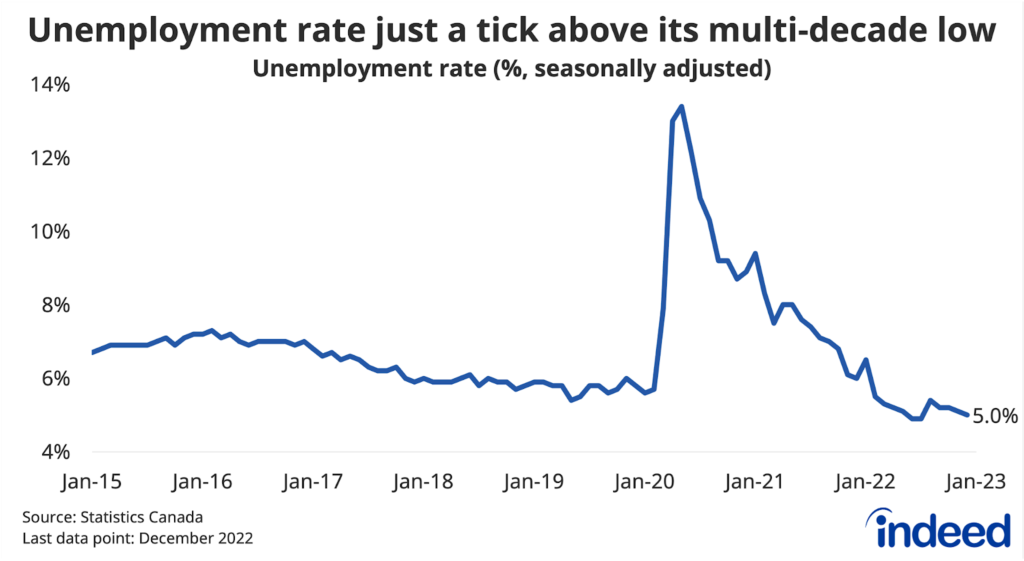Key Points:
- In the second half of 2022, 6.1% of Ontario job seeker clicks on Canadian job postings were for positions in other provinces, up 49% from the second half of 2019.
- Outbound interest to BC and Nova Scotia from Ontario spiked at the start of the pandemic, while Alberta has led growth since, overtaking both Quebec and BC as the top recipient of Ontario job seeker clicks.
- Ontarians looking for tech, engineering, and natural-resource-related jobs have been especially likely to search outside the province.
- Growth in outbound interest since 2019 has been broad-based, but especially strong in remote-friendly fields like tech and marketing.
- The persistent rise in outbound job seeker interest from Ontario suggests the recent wave of outmigration from Canada’s largest province could continue, but also highlights how the rise of remote work has expanded the geographic scope of white-collar job search.
In the first three quarters of 2022, 83% percent more Ontarians left for other provinces than during the comparable period in 2019, according to Statistics Canada. This shift was already under way in 2021, probably reflecting cost-of-living challenges, especially in the Greater Toronto Area, and greater location flexibility offered by the surge in remote work during the pandemic. Changes in job seeker activity on Indeed suggest this trend could continue.
In the second half of 2019, 4.1% of clicks on Canadian job postings on Indeed made by job seekers with IP addresses in Ontario were for positions in other provinces. The outbound click share spiked at the start of the pandemic and remained above 5% through 2020. Since then, out-of-province interest has trended up further. In the second half of 2022, 6.1% of Ontarian clicks went to postings for jobs elsewhere in Canada, a 49% increase from three years earlier.
The initial jump in out-of-province interest went to BC and Atlantic Canada, while Alberta has trended up since
The rise in outbound interest evolved in two phases, the first probably reflecting the initial reaction to the pandemic, followed by a more gradual shift in response to escalating cost-of-living in central Canada.
The Ontario outclick share rose across provinces in mid-2020, but the rise was especially notable in postings for jobs in BC and Atlantic Canada, primarily Nova Scotia. Interest in these areas has remained at elevated levels since.
More recently, Ontario job seekers have turned their sights to Alberta and, to a lesser extent, Quebec. Alberta stands out. After waning prior to the pandemic, 1.7% of all Canadian clicks made by Ontarians in the second half of 2022 were on ads for jobs based in Alberta, the most of any province, and nearly double the 0.9% Alberta share in the second half of 2019.
STEM and natural resource job seekers most likely to look out of province
Ontario job seekers’ propensity to click on out-of-province postings varies across job types. For one, the payoff to landing work outside Ontario is greater for some occupations than others. Meanwhile, the characteristics of job seekers looking at different fields also vary. For instance, some are more likely to be at an age when a work-related move to another province is more feasible.
At the low end, just 2.6% of Ontario clicks for retail jobs in 2022 were on postings located outside the province. The outclick rate was also below 5% across a range of lower-paying service sector fields, such as food services, loading and stocking, and cleaning and sanitation. Outclick shares for these positions could be lower than average because Ontario’s minimum wage is similar to BC’s and slightly above Alberta’s and Quebec’s. Moreover, these positions may also attract a greater share of job seeker interest from teens, who might move for work less often than others.
At the higher end, in 2022, over 10% of Ontarian clicks on a range of Canadian STEM postings were on jobs located elsewhere. The same was true for postings in aviation, agriculture, and mining. Clicks on certain engineering jobs (as well as manufacturing jobs) in Alberta were especially elevated, while software development jobs in BC got disproportionate attention. In both cases, offered wages for these occupations tend to be higher in their respective provinces than in Ontario. Meanwhile, newcomers to Canada, who have a greater propensity to move across labour markets, often work in these jobs at higher rates than others.
In between, Ontario outclick rates in 2022 stood closer to the 6% overall average across a range of fields spanning accounting, construction, and driving.
Remote-friendly fields saw the largest rise in out-of-province clicks
The Ontario out-of-province click share grew across all job types from 2019 to 2022. Nonetheless, underneath the overall 47% annual increase, growth varied substantially. In particular, outclick shares rose especially quickly among people looking for remote-friendly work, while the extent of increases were more mixed for in-person roles
The share of Ontario clicks on occupations in remote-friendly sectors like tech and marketing — where over a quarter of job postings mentioned remote work in mid-2021 — going to the rest of Canada soared over 75% from pre-pandemic levels. Several fields where remote references occurred in 10-20% of postings, like accounting, customer service, human resources, and education, also registered above-average increases in outclick shares.
Meanwhile, Ontario job seekers looking for work in predominantly in-person sectors didn’t shift their job search out of province as much. The share of clicks on postings outside Ontario rose a more-modest 14% and 16% respectively in food services, and loading and stocking, while it barely budged in retail trade. Outclick shares also rose less than average in several areas of health care and social assistance, such as personal care and home health, childcare, and medical technicians, though nursing was a notable exception.
Jump in out-of-province interest highlights Ontario’s challenges, but also opportunities for job seekers
The rise in Ontario outbound clicks seems to reflect two trends. First, Ontario’s high cost of housing, only rivaled by BC’s, is probably pushing some residents elsewhere, especially when job opportunities are plentiful across the country. Affordability challenges bite across the income spectrum and the share of clicks going outside Ontario has risen for jobs of varying wage levels.
Given the persistent disparity in housing costs across Canadian regions, the upward shift in the share of Ontario job seeker interest outside the province suggests the trend could last some time.
What does this mean for recruitment? Offers of relocation assistance could help employers in other provinces stand out, especially in fields in which outbound interest is high, like tech, engineering, and the natural resource sector.
Faster growth in Ontario outclick shares among those looking for remote-friendly work suggests other factors beside cost-of-living have also contributed to the rise in out-of-province interest. One factor may be the greater flexibility afforded by remote work. The ability to perform a job far from a central workplace makes moving, including for a new position, easier. For instance, someone interested in moving to BC and looking at software jobs nominally based in Vancouver might also have the option of living in Kelowna or Victoria instead.
Perhaps even more important is the possibility that some of the rise in out-of-province interest in remote-friendly jobs might be among Ontarians who aren’t looking to move, but simply want to expand the geographic scope of their job search. With fully remote work likely to represent a significant share of certain jobs in the years ahead, more workers will live in places far from the locations where jobs are posted than in years past. This will expand both the number of job openings available to white collar job seekers across Canada, while also increasing the candidate pool for employers looking to fill these positions.
Methodology
We assess out-of-province job seeker interest from Ontario by tracking the share of clicks on Indeed postings for jobs in Canada, excluding clicks going to other countries, by people with IP addresses in Canada’s largest province. All data in the post reflect seasonally adjusted, weighted 28-day moving averages, unless otherwise specified.



